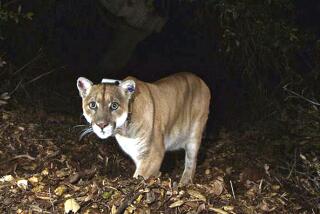Sightings of Cougars Test Extinction Theory
BALTIMORE — Wildlife experts believe the cougar is long gone from the Eastern United States, but amateurs say they have seen the big cats.
“Wildlife biologists say anyone who sees them either has rocks in their belfry or they ask them, ‘What have you been drinking?’ ” says John Lutz.
Lutz and his wife, Linda, operate a 24-hour “cougar hot line” at their home in Baltimore and have recorded numerous sightings of Felis concolor , also known as the mountain lion, cougar, panther, painter, catamount or puma.
The big cats thrive in the West and a few members of a subspecies live in Florida, but wildlife biologists say the eastern puma became extinct more than 75 years ago.
“The U.S. Fish and Wildlife Service’s position on this is that there are no wild, breeding populations of cougars in the East,” said Paul Nickerson, Northeast regional chief of the service’s endangered species division. “We don’t question the validity of some of the sightings, but we do not consider these to be eastern cougars.”
The eastern puma was smaller than the western puma. An adult eastern puma weighed 60 to 125 pounds and was about 5 feet long, not counting its tail. They were gray, black or tan.
Since he started logging reports on July 1, 1983, Lutz has recorded 770 sightings of such cats in 23 states east of the Mississippi. In 44% of these, the cat was seen by more than one person, he said. Last year alone, 149 big-cat sightings in 13 states were reported, he said.
“All these people can’t be wrong,” said Lutz, an employee of Baltimore’s transportation department who has studied cougars on his own for 25 years.
“Sightings are being reported in increasing numbers all over the East Coast,” Lutz said in an interview at his home. “I’m firmly convinced that the eastern puma is roaming.”
Without hard evidence to the contrary, however, state and federal wildlife biologists suspect that other animals are being mistaken for cougars, or the cougars seen were pets released into the wild.
“We’ve had a couple sightings that we’ve gone out to investigate and they turned out to be house cats or brown dogs,” said Ken Elowe, a biologist with the Maine Department of Inland Fisheries and Wildlife. “We get about 25 sightings a year, but we have yet to have one confirmed.”
Cal DuBrock, director of the Pennsylvania Game Commission’s bureau of wildlife management, said his agency had received fewer than a dozen such reports in the last two years.
“In every instance, they were traced back to cougars that had been in captivity and released,” DuBrock said.
Paul W. Rego, wildlife biologist with the Connecticut Department of Environmental Protection, said he did not believe that mountain lions roamed the woods of his state.
“We’ve had reports. None substantiated,” Rego said. He said an investigation of one report turned up only coyote tracks.
More to Read
Sign up for Essential California
The most important California stories and recommendations in your inbox every morning.
You may occasionally receive promotional content from the Los Angeles Times.










